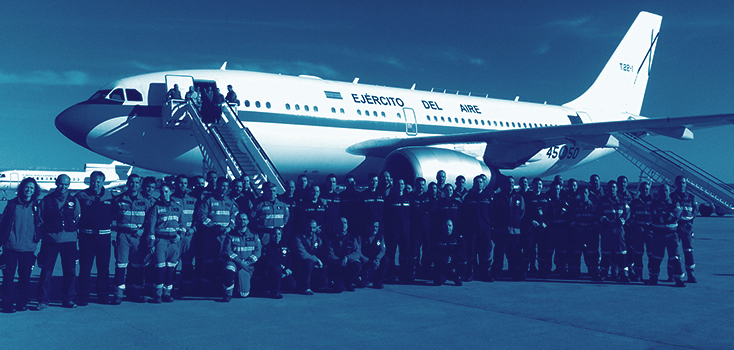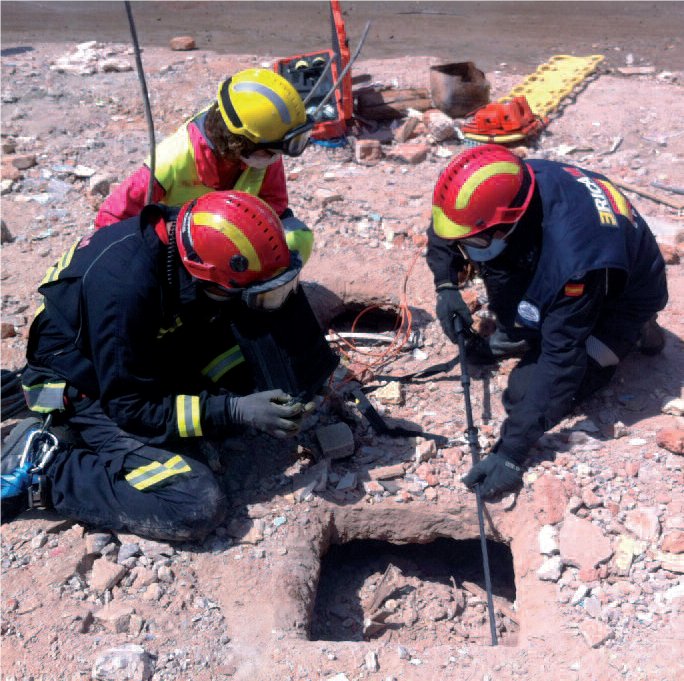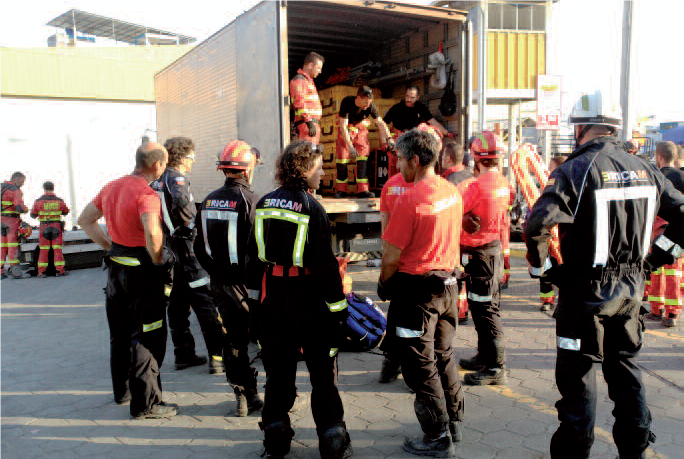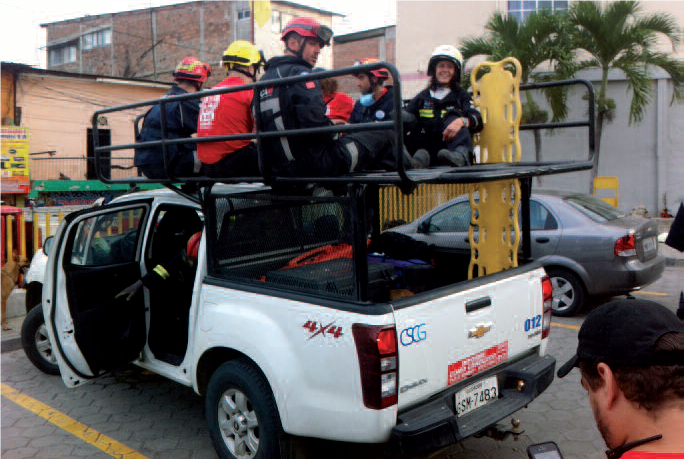
ERICAM Madrid Immediate Response to International Catastrophes Group
Everyone who works in emergency services knows that these services are prepared to deal with the incidents of multiple victims that may occur. But there are many members of EMS teams who do not know that there are teams specialized in urban catastrophes. This article, written by Ana María Cintora, member of this group and of the Experts and Advisory Board of iProcureSecurity project, aims to make visible what an USAR group is. Another article will detail as an example its operation and experience in the earthquake in Ecuador in April 2016.
The United Nations Organization (UN) manages and coordinates an Urban Search and Rescue Advisory Body called INSARAG (International Search and Rescue Advisor Group). It was created in 1991 as a result of the Spitak earthquake, Armenia (1988) that resulted in 25,000 deaths; it developed as a consequence of UN resolution 57/150 of December 16, 2002. This body coordinates, evaluates and supervises rescue groups specialized in urban disasters worldwide. It also publishes guides that spin the operation of these groups.
There are only two Spanish teams, which are authorized and accredited by INSARAG as a USAR team (Urban Search and Rescue – Urban Search and Rescue Team):
1 – ERICAM, is the Emergency and Immediate Response group of Madrid region. It is the group to which the author belong.
2 – UME, the Spanish Military Emergency Unit.
Both groups have the necessary qualification and validation of INSARAG and the UN to intervene in major international catastrophes.
Depending on the logistic capacity, work capacity and self-sufficiency in energy, food and food, the equipment can be small, medium or large. Regardless of their size, all of them must have at least one doctor and one nurse although their operation increases as the group becomes more numerous, with the group also having emergency technicians.

GOALS
USAR groups are responsible for the search and rescue of possible survivors buried in the rubble of an urban catastrophe. It also deals with their sanitary treatment. They also offer help to the population and perform reconnaissance and shoring of buildings damaged by seismic movement or other disaster.
All groups are made up of rescue personnel – firefighters, telecommunications specialist, logistics expert and health personnel. The functions performed by the nurse in this group are adapted to the end of the team. All personnel comprising the equipment must be versatile, must be prepared to perform the different tasks required depending on the situation and needs. It must be able to overcome the vicissitudes that may arise and replace another partner in their duties if required. Next, the material that is to be taken to the mission will be exposed, so that everyone who wants to take part in the group must familiar with.
MATERIAL
For logistics’ sake a list of all the material is kept, with its specific location in each transport container, and with marking and weight control of each one. It should be borne in mind that the countries where you are traveling will have difficulties in providing mobility, whether by air or by land, and the weight and material must be taken well when crossing customs, going up to the different means of transport and riding the camp. It is also have to be assesses that being a medium equipment to use, water and food to supply each team for 7 days must be carried.
Regarding communications, the necessary material to set up a coordination center has to be included in case there was none before, at the time of arrival at the disaster zone. There should be included also radio systems in case the usual communications remain inoperative after the catastrophe, in addition to autonomous electricity systems and satellite communication. In order to be able to locate of people trapped in a collapsed structure carry geophones must be taken. They are seismic sensors that detect the presence of victims and precisely locate their location under the ruins. Telescopic poles with a search camera must be also included to allow communication with the injured through the rubble.
Together with the group there are two canine guides with dogs trained to search for both living and deceased victims.
For the extrication of patients: There is a complete range of material that includes radial and holes for drilling walls and debris, for cutting, shoring, and lifting loads in case of complex rescue situations.
Taking into account that there is the possibility of encountering polytraumatized patients, it is mandatory to have complete immobilization material: collars, limb splints, spinal board and a kendrick device. As transport material canvases and stretchers are included.
The material for height rescue, such as harness kits, pulleys, sealers, winches, tripods, rappel belt are brought.
The sanitary personnel must cart the following material:
- Electromedicine equipment: defibrillator monitor, pulse oximeter-capnograph and portable volumetric respirator next to an oxygen bullet.
- Medication case with serum therapy, material for minor surgery and emergency assistance in incidents of multiple victims.
Apart from two sanitary containers, for an advanced medical post, each member must carry catastrophe intervention backpacks that contain the sanitary products and material for initial triage and respiratory and intravenous emergency treatment.
Finally, the equipment comprises out treatment for patients with possible crushing syndromes, compartment syndrome and possible amputations (guidelines of the WHO Guidelines for these cases).
CONCLUSION
The start-up of USAR teams favors the coordination of disaster relief. The specific health profile for the staff, both medical and nursing, that integrates these teams, is far from the purely assistance, and is much broader than that required for work in daily emergency services.
It is beneficial to publicize and promote the development of skills and knowledge of firefighters, nurses, medicine, emergency technicians and dog guides required for this field.
REFERENCES
- Guías Insarag https://www.insarag.org/methospa/guias [Visitado el 01/03/2017]
- INSARAG Guidelines Vol II Manual A – SPA Pág 39 y 40
- Manejo Médico de Pacientes Atrapados con Sindrome de Aplastamiento Medical Guidance Note. Translated by Soledad Gómez de la Oliva (2016)
- https://extranet.who.int/emt/content/management-limb-injuries-during-disasters-and-conflicts [09/12/2019]
- Procedimiento operativo del Equipo de Intervención Sanitaria de ERICAM. SUMMA112.
- Basic Security in the Field II (Spanish). https://training.dss.un.org/course/detail/19944 [09/12/2019]
- Global Disaster Alert and Coordination System http://www.gdacs.org/
- http://www.madrid.org/cs/Satellite?c=CM_Actualidad_FA&cid=1354586457820&language=es&pagename=ComunidadMadrid%2FEstructura
- Búsqueda y rescate en estructuras colapsadas. Manual de campo. Oficina de Asistencia para desastres del Gobierno de Estados Unidos. (USAID) 2006. Pág 19.



